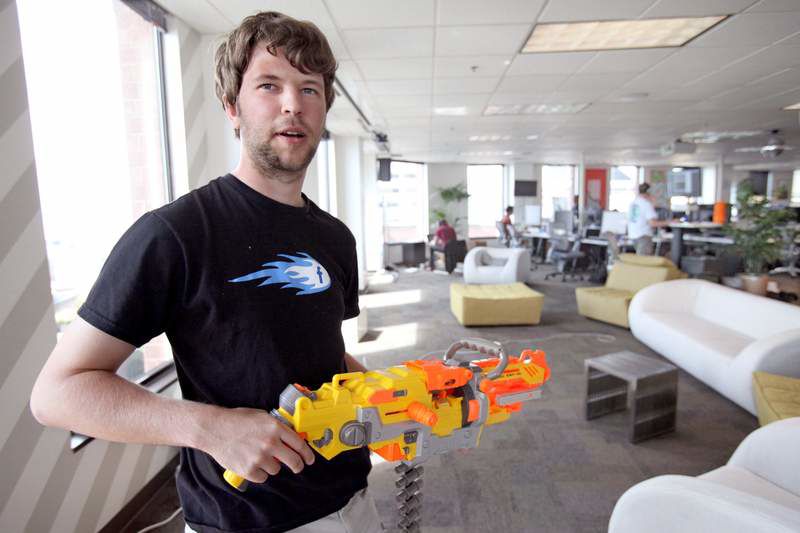Nonstop ideas fill no-frills Facebook office in Seattle
Published 5:00 am Thursday, August 11, 2011

- Intern Cullen Walsh looks for battle with his Nerf gun at Facebook's office in Seattle.
SEATTLE — For its first-year birthday present, the Facebook Seattle office is getting another floor of its downtown office building near Pike Place Market.
That, plus cupcakes and a cake with company logos and a party on Lake Washington.
The office — Facebook’s first development center outside of its Palo Alto, Calif., headquarters — ends its first year Tuesday with about 50 engineers.
Its second floor creates room for 30 or so more, who will be lured from Microsoft, Google, Amazon.com and startups.
Managers are already thinking about moving to a larger facility, which they’ll need sometime in 2012 if they keep hiring at the same pace.
“As fast as we can find good people and absorb them, we’ll hire them,” said engineering director Peter Wilson, 46.
Wilson’s a Microsoft veteran who also managed the Google office in Kirkland, Wash., that was started in 2004. Now Google is a midsize software firm in the area, approaching 1,000 people in Kirkland and Seattle, as upstarts like Facebook move in. The social-networking giant is among a handful of California companies that set up offices here in the past year, raising competition for the area’s top software developers.
Facebook doesn’t have a fancy cafeteria or swishy digs to entice employees in Seattle. Its office overlooking Elliott Bay is basically an open space with a few desk clusters, at which engineers quietly clack away in front of huge displays.
There are video games, Nerf guns and a kitchenette to serve lunches ordered in.
The main attractions are the chance to quickly produce software that will reach 750 million users and extend Facebook’s social features across the Web.
“It’s the most ridiculous ratio of users per developer. … I can’t think of any place that has over a million users — ordinary, active users — per developer,” said Eugene Zarakhovsky, 32, who came from MySpace; before that, iLike and Microsoft.
In Seattle, Facebook started by moving a handful of engineers from Palo Alto and hiring experienced people from other companies — “leaders who could set a good example for the office,” said Ari Steinberg, 28, the engineering manager who started the office.
The office produced the Skype video-chat feature launched in June, which was built largely by Microsoft veteran Philip Su, 35. It also produced a converter used when people access Facebook from mobile devices to automatically display a version that works with their hardware. It’s also working on the platform, infrastructure, ads, desktop software and Places, a location check-in service.
Here are excerpts from conversations at the office last week:
Q: Why did you choose to work for Facebook?
A: Su: I felt like the Internet is fundamentally changing, from an Internet where everybody is anonymous to the sites they use, to an Internet where the sites out there understand who you are, your relationships and what things you love. Facebook is at the core of that revolution now.
Q: Did your previous employers not get this as much, or can Facebook just do this faster?
A: Zarakhovsky: Previous employers being Microsoft, they didn’t get it as much. Previous employers being startups, they got it, but the impact wasn’t nearly as high. It’s amazing that Facebook manages to move as fast as a decent-size startup, even though it’s many times larger.
Q: Has Facebook found a good balance of efficiency without too much management?
A: Zarakhovsky: We ship pretty much everything every single week. Full push on everything in code base every week. Not everything’s enabled, of course, but I don’t know of any company even close to this size that’s capable of doing this. It’s normal for startups to ship daily or weekly; it’s not normal for companies with 750 million users. If you want to make a change, it will never take you more than a week to get it up.
Jeffrey Dunn (23-year-old who came from Microsoft): Companies like Microsoft, we’d be lucky to release once a month. The big issue is, if you have an idea — and 75 percent of your ideas end up being garbage. If you can only try one every month, then you don’t get very good feedback, you can’t try very many ideas, you don’t get many successful ideas out there. If you can try an idea every week, by the end of the year you have many more successful ideas that actually got out to users.
Steve Ringman / Seattle Times
Intern Cullen Walsh looks for battle with his Nerf gun at Facebook’s office in Seattle.






